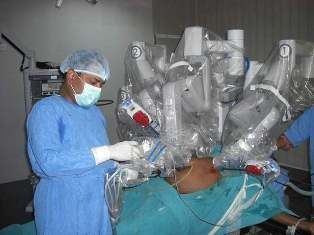Robotic surgery has revolutionized the field of surgery in recent years, offering several advantages over traditional surgical techniques. Robotic surgery involves the use of robotic systems to assist surgeons in performing minimally invasive surgical procedures with greater precision, dexterity, and control. In 2015, the International Conference of Robotic Surgery, also known as Robosurge 2015, was held in Singapore. This conference brought together experts in robotic surgery from around the world to discuss the latest advancements and innovations in the field. In this essay, we will discuss the highlights of Robosurge 2015 and its impact on the field of robotic surgery.
Key Highlights of Robosurge 2015:
- Advances in Robotic Surgery Technology:
One of the key highlights of Robosurge 2015 was the discussion of advances in robotic surgery technology. Several companies showcased their latest robotic surgery systems, including the da Vinci Surgical System from Intuitive Surgical, the Versius Surgical System from CMR Surgical, and the Senhance Surgical System from TransEnterix. These systems offer improved features such as enhanced visualization, better ergonomics, and more advanced instruments.
- Training and Education:
Another important topic discussed at Robosurge 2015 was the need for standardized training and education in robotic surgery. As the use of robotic surgery continues to expand, it is essential that surgeons receive proper training and education to ensure safe and effective use of the technology. Several organizations, such as the European Association of Robotic Urological Surgeons and the Society of Robotic Surgery, have developed guidelines and standards for training and education in robotic surgery.
- Clinical Applications:
Robotic surgery has been used in a wide range of clinical applications, including urology, gynecology, cardiothoracic surgery, and general surgery. At Robosurge 2015, experts discussed the latest clinical applications of robotic surgery, including single-incision robotic surgery, robotic-assisted hernia repair, and robotic-assisted colorectal surgery. These procedures offer several advantages over traditional surgical techniques, such as reduced pain, shorter hospital stays, and faster recovery times.
- Cost-effectiveness:
Robotic surgery systems can be expensive, and the cost-effectiveness of these systems has been a topic of debate. At Robosurge 2015, several speakers discussed the cost-effectiveness of robotic surgery, citing studies that have shown that the use of robotic surgery can lead to cost savings due to shorter hospital stays and reduced postoperative complications.
Impact of Robosurge 2015 on Robotic Surgery:
Robosurge 2015 had a significant impact on the field of robotic surgery, highlighting the latest advancements and innovations in technology, training and education, clinical applications, and cost-effectiveness. The conference helped to foster collaboration and discussion among experts in the field and raised awareness of the benefits and potential drawbacks of robotic surgery. Some of the key impacts of Robosurge 2015 on robotic surgery include:
- Increased Adoption of Robotic Surgery:
The discussions and presentations at Robosurge 2015 helped to increase awareness of the benefits of robotic surgery and to promote its adoption in clinical practice. As a result, the use of robotic surgery has continued to expand in various fields of surgery, including urology, gynecology, and general surgery.
- Improved Technology:
The discussions and presentations at Robosurge 2015 helped to spur innovation and development in robotic surgery technology. Several companies have since released new robotic surgery systems with improved features and capabilities.
- Standardization of Training and Education:
The discussions at Robosurge 2015 helped to highlight the need for standardized training and education in robotic surgery. As a result, several organizations have developed guidelines and standards for training and education in robotic surgery, helping to ensure that surgeons receive proper training and education before using robotic surgery systems in clinical practice.
Enhanced Clinical Applications:
The discussions at Robosurge 2015 also helped to promote the development and application of robotic surgery systems in new clinical areas. As a result, robotic surgery systems have been used in a wider range of clinical applications, including single-incision surgery, hernia repair, and colorectal surgery.
Cost-effectiveness:
The discussions at Robosurge 2015 helped to promote the evaluation of the cost-effectiveness of robotic surgery systems. As a result, several studies have since been conducted to assess the cost-effectiveness of robotic surgery, helping to inform decision-making about the use of these systems in clinical practice.
Challenges and Limitations:
While Robosurge 2015 highlighted the potential benefits and advancements of robotic surgery, there are also several challenges and limitations associated with the technology. Some of the key challenges and limitations include:
High Cost:
Robotic surgery systems can be expensive, and the initial investment and ongoing maintenance costs can be a barrier to adoption in some healthcare settings.
Limited Access:
Robotic surgery systems are not widely available in all healthcare settings, particularly in low- and middle-income countries. This limited access can result in disparities in access to care for patients who may benefit from robotic surgery.
Technical Complexity:
Robotic surgery systems are complex and require specialized training and expertise to operate effectively. The technical complexity can result in longer surgical times and increased risk of complications if not used properly.
Lack of Long-term Data:
While robotic surgery systems have been used in clinical practice for several years, there is still limited long-term data on their safety and effectiveness. More research is needed to fully understand the potential benefits and drawbacks of these systems.
Conclusion:
Robotic surgery has revolutionized the field of surgery, offering several advantages over traditional surgical techniques. Robosurge 2015 was an important conference that highlighted the latest advancements and innovations in robotic surgery technology, training and education, clinical applications, and cost-effectiveness. The conference helped to foster collaboration and discussion among experts in the field and raised awareness of the benefits and potential drawbacks of robotic surgery. Since the conference, there have been significant improvements in robotic surgery technology, training and education, clinical applications, and cost-effectiveness. However, there are still challenges and limitations associated with the technology that need to be addressed to ensure safe and effective use of robotic surgery in clinical practice. Overall, Robosurge 2015 was an important event that helped to advance the field of robotic surgery and promote its adoption in clinical practice.
